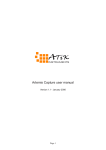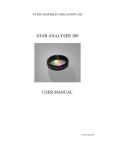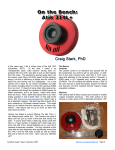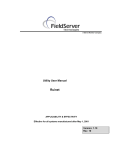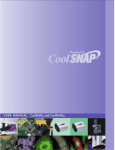Download ATIK Cameras 4 Series User manual
Transcript
Atik Instruments Series 3 user manual Version 1.0 – May 2008 Page 1 Table of contents 1 2 3 Introduction............................................................................................................3 Pack Contents.........................................................................................................4 Atik Instruments Series 3.......................................................................................5 3.1 Camera Parts ..................................................................................................5 3.2 CCD ...............................................................................................................6 3.3 Analog to Digital Converter (ADC) ..............................................................6 3.4 Power Consumption.......................................................................................6 4 Ports .......................................................................................................................7 4.1 USB Port ........................................................................................................7 4.2 Auto Guiding Port..........................................................................................7 5 Thermal Stabilization.............................................................................................7 6 Additional Technical Information..........................................................................8 7 Software Development Kit ....................................................................................9 8 Accessories ..........................................................................................................10 9 Artemis/ATK Capture..........................................................................................11 9.1 Features ........................................................................................................11 9.2 Using Artemis Capture ................................................................................12 9.3 Quick Start ...................................................................................................13 9.4 Main Screen .................................................................................................13 9.5 Exposure Settings Dialog.............................................................................14 9.6 Display Options Dialog................................................................................15 9.7 Focus Assist .................................................................................................16 9.8 Colour cameras and the ArtemisRGB utility ...............................................17 9.9 Other controls...............................................................................................20 10 Maxim DL™ plug-in .......................................................................................21 11 AstroArt Plug-in...............................................................................................23 Page 2 1 Introduction Atik Instruments Cameras represents today’s affordable and easy way to achieve high quality images with a superior design. This version has new redesigned hardware in order to answer the growing demand in fine quality astrophotography cameras. A wide range of accessories is also available in order to answer the needs of the most demanding astrophotographer. The product you have purchased is a fine piece of hardware and will bring you many moments of satisfaction, however, in order to maintain the product’s quality any changes to the supplied camera and/or accessories without the manufacturer’s written permission will void your warranty. Any further development will be available to you through your local dealer or at www.atikinstruments.com. Please take the time to read this document thoroughly in order to get the most out of your Atik Instruments Camera. After doing so, get out there and discover new worlds… Page 3 2 Pack Contents This pack includes: • • • • • 1- Atik Instruments ATK314L/E 2- USB cable 3- Car lighter type power cable 4- CD-ROM with Software and manuals 5- Quick start guide Page 4 3 Atik Instruments Series 3 3.1 Camera Parts • • • • 1- Autoguider port 2- Power input 3- 1.25” Nosepiece 4- USB port Page 5 3.2 CCD The used CCD in your camera depends on the model and on the fact if it’s a color or black and white camera. Below is a table showing the CCD used in the two options: Black and White Color Atik Instruments 314L SONY ICX285AL SONY ICX285AQ Atik Instruments 314E SONY ICX205AL SONY ICX205AQ Due to the very clean nature of these CCD’s dark frames are in most cases unnecessary. This is due to the low noise which stands at an amazing less than 5 electron RMS. The optical window used in front of the CCD is a BK7 with BBAR coatings on both sides assuring that no reflection will appear in your image. 3.3 Analog to Digital Converter (ADC) The Analog to Digital Converter (ADC) is a 16bit ADC. This means that your Atik Instruments 16IC camera will allow you to record subtle levels of gray providing you enhanced dynamic range when capturing an image. 3.4 Power Consumption Your Atik Instruments camera was electrical and electronically designed in order to have low power consumption so your autonomy is enhanced one step further. Versatility is a very important feature since the 12V used by Atik Instruments Series 3 cameras can be plugged almost everywhere: e.g. car battery or any other source which provides 12V. The less than 800mA that the camera consumes in full operational status provides extended autonomy. Page 6 4 Ports 4.1 USB Port An USB 2.0 High Speed connection is use on the new Series 3 cameras. This meand tha downloads are now very fast, taking less than 2 seconds. This improves greatly on the readout gradient that is usually present on slower readout speeds. A higher speed “preview” mode is also present, providing roughly twice the speed. 4.2 Auto Guiding Port Atik Instruments Series 3 cameras are compliant with this industry’s demanding features. The auto guiding port enables you to do auto guiding with any ST4 compatible guiding software when using the optional cable. See accessories. You will find this port schematics on section 6. 5 Thermal Stabilization Atik Instruments cameras are thermally stabilized in a way that your CCD will output the best result that it can deliver. This information often appears with the indication ΔT= -x where x in this case is 25. This means that the CCD’s temperature will drop approximately 25º C below outside temperature. This is a thermoelectric process and therefore in order to obtain the best results you should wait 1 to 2 minutes until thermal stabilization is achieved. This fact also depends on the outside temperature so, higher environment temperatures will demand more time for the CCD to stabilize. The very low readout noise, combined with an efficient cooling system, permit the user to simply bypass Dark frames in most situations. Therefore, you can spend more time imaging, and less time worrying with darks. Page 7 6 Additional Technical Information Atik 314L Atik 314E Sensor Type Sony ExView Sony SuperHAD Horizontal Resolution 1392 pixels 1392 pixels Vertical Resolution 1040 pixels 1040 pixels Pixel Size 6.45 uM x 6.45 uM 4.65 uM x 4.65 uM ADC 16 bit 16 bit Readout Noise (Typ.) 4 e- 4 e- Interface USB USB Power 12v DC 0.8A 12v DC 0.55A Maximum Exposure Length Unlimited Unlimited Minimum Exposure Length 1/1000 s 1/1000 s Guide Port ST-4 compatible ST-4 compatible Cooling Thermoelectric Thermoelectric Weight Approx. 400 g Approx. 350 g Pinouts for the external ports: Autoguider port Distance from top of T-thread to focal plane: Aprox 12 mm Optical window thickness: 2mm Page 8 The following table refers to the angular resolution per pixel with certain focal distances. The formula to calculate any other focal length not described is: Pixel Size (mms) / Focal Distance (mms) * 206,3 = result in arc seconds/pixel (angular resolution) Focal Distance (mm) 350 400 450 500 550 600 650 700 750 800 850 900 950 1000 Angular resolution (arcsec/pixel) – 314L 3.80 3.33 2.96 2.66 2.42 2.22 2.05 1.90 1.77 1.66 1.57 1.48 1.40 1.33 Angular resolution (arcsec/pixel) – 314E 2.74 2.40 2.13 1.92 1.74 1.60 1.48 1.37 1.28 1.20 1.13 1.07 1.01 0.96 7 Software Development Kit Due to the fact that our ever changing World is always finding new applications for Atik Instruments cameras, a software development kit is available at www.atik-instruments.com . This SDK is free of charge for now. Page 9 8 Accessories There are several accessories from Atik Instruments that will allow you to go further into this never ending journey of discovering new worlds. These include the following • • • • IR Filter Focal Reducer 0,5x Manual Filter wheel Motorized filter wheel Other accessories will follow up very shortly, which will enhance even further the joy of astrophotography. Page 10 9 Artemis/ATK Capture Artemis/ATK Capture is a standalone program which allows you to control your Atik Series 3 camera, take images, preview them, and save them to standard FITS files. It does not perform any image processing, other than simple histogram manipulation for mapping the 16-bit images to the display. The data saved in the FITS file is exactly what is read from the camera (raw), so any adjustment is purely for display purposes. Focus should be very easily achieved with focus assist as described further. 9.1 Features The capabilities of Artemis/ATK Capture include: · Control over exposure time, from 1milisecond (0,001s) upwards. · Control over pixel binning. · Selection of an image sub-frame for rapid focusing. · Automatic capture of a series of images, saved with sequential file names. · Adjustment of black and white levels, and log stretch for displaying images. · Focus Assist option using data gathered from star images · Zoom feature. · Display adjusted for aspect ratio for sensor whose pixels aren’t square. · Night-vision mode. · Cooler switching. Page 11 9.2 Using Artemis Capture The main Screen When you first start the program, you will be warned if your Atik Series 3 camera is not connected or powered up. It is possible to run the program without the camera by clicking on “ignore”, although most of the functions will be unavailable. The main settings in Artemis Capture are controlled using two dialogs, the ‘display options’ dialog and the ‘exposure settings’ dialog. Both of these are a modeless dialog, which means that they can be left open while you run the program and capture images, etc. However you should be aware that if one of these dialogs is selected then certain keyboard shortcuts or mouse operations in the main window may not behave as expected. If this happens, simply click on the main window to select it. Page 12 9.3 Quick Start WARNING: The cooler is off by default. You should turn it on using the cooler control icon. When the cooler window appears, just press "Cooler On". To turn it off, just press "Warm Up". If you want to simply take a quick shot to verify that the program and camera are working correctly, you can use the F1-F8 buttons to take a single test image. F1-F4 take an exposure of 0.1, 1, 5 or 10 seconds respectively, and F5-F8 use the same exposure times but binned at 2x2 for greater sensitivity. Here’s a list of shortcuts: F1: 0,1s F2: 1s F3: 5s F4: 10s F5: 0,1s (binned) F6: 1s (binned) F7: 5s (binned) F8: 10s (binned) The “Quick” menu 9.4 Main Screen The main window in Artemis capture is used for displaying the most recently captured image. A green outline rectangle is displayed in the window, indicating the full size of the CCD sensor. If a sub frame is being used for imaging then it is indicated by a red outline rectangle within the green one. You can scroll the display using the scrollbars, or by dragging it with the left mouse button. Dragging the right mouse button within the CCD area allows you to set the sub-frame interactively. If you have a mouse with a wheel, you can use the wheel to zoom in and out - the point beneath the mouse pointer is the ‘focus’ of the zoom, and remains in the same place on the display. Sub-Frame selection Page 13 9.5 Exposure Settings Dialog This dialog is displayed by selecting the ‘View |Exposure Settings’ menu option, or by clicking the toolbar button. Here you are able to set the exposure time for the image, the individual X and Y binning factors, and you can numerically specify a sub-frame if you wish. The "Pre" check box, activates the preview mode, where that image download will be about twice as fast. However, quality will suffer. This mode is specially useful for focusing the camera. Also, a delay between exposures setting is available, since it is desirable to have the auto guider stabilize before starting the next exposure. This can be set in the “Dly(s)” box, and it’s measured in seconds. The Exposure dialog box If the Autosave box is checked then every time an image is captured, it will automatically be saved as a FITs file with a sequence number appended to its name, in the form C:\Artemis_001.fit. Once you have selected the exposure settings, you can take a shot using the Camera |Snapshot’ menu option, or by clicking the camera toolbar button. The indicator at the bottom right of the window shows the current camera status exposure time remaining, download state, etc. Once the image is downloaded it will be displayed on the main screen you can adjust the display using the ‘Display Options’ dialog. Page 14 9.6 Display Options Dialog This dialog is displayed using the ‘View |Display Options’ menu item, or by clicking the toolbar button. It allows you to adjust the way in which the 16-bit image is mapped to the PC’s display. In general, two values are chosen within the range of 16 bit numbers present in the image. Pixel values equal to or less than the lower value are displayed as black, and pixel values equal to or greater then the higher value are displayed as white. Values in between are displayed as shades of grey. The ‘Log’ value controls how the grey shades are distributed – a value of zero produces a linear map, negative values provide higher contrast at the higher end, and positive values boost the contrast at the lower end. The ‘Auto stretch’ box allows the program to automatically adjust the black and white levels each time an image is captured. The levels are chosen such that only a few pixels fall outside the range. If the box is unchecked then you can manually adjust the black and white levels using the sliders. The ‘Reticle’ checkbox will add a reticule to the displayed image. It may be of use for determining the center of the frame, so that you can align your goto telescope, for example. The ‘Negative’ checkbox will display the image as a negative, which can be useful when trying to spot faint objects on a dark background. The ‘Correct aspect ratio’ box adjusts the displayed image according to the physical dimensions of the pixels on the CCD sensor. If the box is checked then the height of the displayed image is scaled so that a square area on the screen corresponds with a square area in the sky. ‘Night Vision’ changes the Windows colors to shades of red, in order to help preserve visual dark adaptation when using the program at night. When the program shuts down, or the box is unchecked, the original colors are restored. [Hint: You can save the night vision color scheme for use with other programs, if you click the checkbox and then right-click the Windows desktop, select ‘Properties |Appearance’ and then ‘Save as’. Give the scheme a name such as Night Vision and you can then return to it any time you like The Dialog box using this dialog. You may also want to save your standard color scheme, so that you can re-select it after using the Night Vision scheme.] Page 15 9.7 Focus Assist When taking an astronomical image it is critical that focusing be as accurate as possible. To help achieve this, Artemis Capture provides the Focus Assist dialog. When you have the camera roughly focused so that you can see stars in the captured image, you can activate the focus assist dialog by double-clicking on a star. For best results you need to choose one which is bright but not overexposed, and which has a relatively clear area around it. The program will select the brightest star in the vicinity of the selection, and draw a small box around it. It will also pop up a dialog showing some information about the Star’s image, in a large bold font so that you can read it when at the telescope which may be some distance from the PC monitor. The information provided is the star’s maximum brightness (the difference between the brightest pixel and the background level), and the width of the star image. This is calculated as the size of a square, centered on the star’s centroid, containing half the total flux from the star. The objective is to adjust the telescope’s focus until the brightness reaches a maximum and the width reaches a minimum - this will give the sharpest and brightest star images. Whilst focusing it is also a good idea to select a sub frame around the star in order to reduce the image download time, and use the zoom feature so that the Star is displayed highly magnified so you can verify that the image quality is improving Focus assist box as you adjust the focus. Then use the camera ‘loop’ button to repeatedly take images until you reach perfect focus as indicated visually and with the Focus Assist dialog. Artemis Capture tracks the star from one exposure to the next by searching for the brightest pixel in the area around the star’s previous location. Depending on the magnification and stability of the telescope, the star may drift by a number of pixels from its previous location. Clicking the ‘Set’ button in the Focus Assist dialog allows you to specify how many pixels the program Page 16 will search around the previous location when trying to locate the star. You can also specify the radius that will be used to measure the star’s properties once it is located - this should be a little larger than the radius of the star, but smaller than the distance to the next star. 9.8 Colour cameras and the ArtemisRGB utility Basically, the Colour version of the Atik Series 3 camera is the same as the monochrome counterpart, both in aspect and functionality. However, it features a CCD which has colour filters built in, enabling the capture of colour images in a single exposure. Artemis/ATK Capture handles these cameras just like the monochrome versions, but features a menu dedicated to colour imaging. The “Colour” menu has 3 options: RAW - Displays the image as it comes from the camera Colour - Displays a synthesized colour image from the RAW data Luminance - Displays the Luminance channel of the image (grayscale) Keep in mind that all these options only affect the way the image is displayed. Images are always saved as RAW data. Since images are saved in RAW data, there is a need to decode colour data for further processing. That’s where the ArtemisRGB utility enters. ArtemisRGB is a standalone application designed to work with FITS files produced from Artemis cameras fitted with colour CCD sensors. The CCD sensors in these cameras have a matrix of colour filters over the sensor elements, so each pixel samples a certain colour of the image. The function of ArtemisRGB is to take this raw image and convert it into a full-color image. Features: · Conversion of images from Primary (RGB) and Secondary (CYMG) mosaics · Allowance for offsetting image on matrix · Adjustable low-pass filtering of colour · Adjustable high-pass filtering of luminance · Adjustable image brightness · Apply same conversion settings to a batch of images · View raw image, colour version, or luminance (grayscale) only · Output in various formats for post-processing, including FIT, TIF, BMP When you start ArtemisRGB, you will see the main image preview area occupying most of the window. On the left is a list which will contain the names of all the images to be processed. Above this are some controls for specifying how the processing is performed, and at the bottom are buttons for dealing with files. Page 17 Artemis RGB screen To import a file, click the ‘Import’ button and locate a FITs file produced by a colour camera. The name of the file will appear in the list box on the left, and the image will appear in the preview window. It may not look quite right at this stage! The ‘Delete’ button can be used to remove an image from the list - it does not delete it from the hard disk. At the top left is a combo box where you can select whether to view the raw, colour, or luminance image. The raw image will show you the checkerboard matrix pattern, but for now we want to see the colour image. Below this combo box is another one in which you can select whether the CCD uses a primary (RGB) or secondary (CYMG) matrix. The Atik Series 3 Colour uses an RGB matrix; If you saved the file from a recent version of Artemis Capture, the colours should already be correct. Otherwise you can try adjusting the X and Y offset values, which tell ArtemisRGB where on the matrix the top left corner of the image lies. For a full-screen image in the standard orientation these values ought to be 0, 0 but if the image has been rotated or flipped then the values will need adjusting. With a bit of trial and error you should find values that give the correct colours. Most deep sky targets are very faint, and because ArtemisRBG doesn’t have any histogram stretching tools, a “Brightness” selection is available, which will allow you to increase the image brightness. This will help to better see the object in the image, but won’t change the image in any way, since it’s for display purposes only. Because some information is lost when the CCD samples the signal into different colours, reconstructing the full colour image can sometimes introduce Page 18 colours which weren’t present in the original scene. These are typically seen in regions of high contrast. To help reduce these false colour artifacts, you can run a low-pass filter (blur) on the colour channel. Then, to restore sharpness to the image, you can run a high-pass filter (sharpen) on the luminance channel. If you have multiple images loaded into ArtemisRGB, you can give each one its own set of processing options if you need to. In particular if some images were saved from a sub frame, then you may need to give them different X or Y offsets. If you make a multiple selection in the image list, the controls at the top of the program will indicate any values which are common to all selected images. If values differ between images then they will be displayed as ‘---’ in the controls. Changing any value will update that value in all selected images this can be a quick way to set the processing parameters for a batch of images. Finally, when you have set all your images as you like them, you can use the ‘Save All’ button to convert all the images to a file format suitable for postprocessing. You can choose to save as separate Red, Green and Blue FITs files, or a single 3-layer FITs file, or a 48-bit uncompressed TIFF file, or a 24bit BMP file. The last option will lose information, but is more compact and more widely used than the other formats. When using the first option each image is saved under its original filename, with _R, _G or _B appended to indicate the colour channel. Page 19 9.9 Other controls There are a few other controls apart from the dialogs described above. The most important are probably the ‘Camera |Snapshot’ and ‘Camera |Loop’ menu options, also available as the two toolbar buttons (the ‘loop’ button is the one with the red circular arrow on it). The Snapshot command takes a single image, and the Loop command starts the program taking repeated images. You can abort the current exposure by clicking the Snapshot button while the exposure is in progress. If you want to terminate the exposure early but keep the result, hold the shift key down while you click the Snapshot button. When looping, you can stop the whole looping process by clicking the Loop button again. The current exposure will be aborted. You can change exposure settings while looping, but they will not be acted upon until the start of the next exposure. ‘Camera |Subframe’ or the red square toolbar button allows you to drag an imaging sub-frame using the left mouse button, which is normally used to scroll the display. You can always use the right mouse button to create a subframe. The green square toolbar button, or the ‘Camera |Fullframe’ option, will revert to using the full CCD area for imaging. ‘Camera |Rotate 180’ will rotate captured images 180 degrees. This also rotates the saved image. ‘Camera |Info’ gives some details of the Atik camera. ‘Camera |Connect’ and ‘Camera |Disconnect’ will connect or disconnect the Atik camera. ‘File |Fits header’ allows you to specify the target object, telescope, and observer name for recording in the header of saved FITs files. The ‘Quick’ menu options allow you to take an instant snapshot at a variety of exposures and binning levels, with a single click or key press. Page 20 10 Maxim DL™ plug-in Introduction Maxim DL is a powerful astronomical program, from Diffraction Limited. It is able to control most of the equipment used in astronomical imaging, as well as processing the captured images. In order to allow Maxim DL to communicate with a new piece of hardware, a driver is required to be installed in a location known to Maxim DL. Installation The driver file for the Atik Series 3 cameras is installed during the initial camera setup (if you selected to install it). If you don’t have the plug in installed yet, just re-run the setup application and select it when prompted. Be aware that you will need to have Maxim DL installed first. Using the Plug-in Once the driver is installed, you can start up Maxim DL and open the CCD Control Window - either by pressing Ctrl+W or by selecting menu option View|CCD Control Window. There may be a short pause while Maxim DL build up a list of available camera drivers, and then you will see the camera setup dialog. In the box headed 'Main CCD Camera', click the 'Setup' button, and in the dialog which appears scroll down the 'Camera Model' list until you find the “ArtemisHSC” camera. Once selected, press connect and you should have a box similar to the one on the right. Keep in mind that, as on the Artemis Captures application, the cooler is off by default. You need to turn it on by pressing the “Cooler On” button. To turn it off, press the “Cooler Off” button. Page 21 Using the Autoguider port The internal autoguider port can be used in two different ways. If you use the Atik Series 3 as a guider camera, you should select “Guider Relays” under Maxim’s Guider options. By using this option, the camera internal relays will be used to send commands to the mount as a standard guider. The second option is if you use the Atik Series 3 as the main camera, and use another camera as guider (for example, a webcam). In this case, you should select “Main Relays” on the Guider options, and all commands to the mount will be routed to the main camera (the Series 3) by Maxim DL. The second option is especially useful, since it only requires a simple camera as a guider, with no extra hardware. A webcam, or any other device capable of Video for Windows interface, will be enough to start taking advantage of autoguiding. You will then be able to take exposures of tens of minutes, unleashing the true potential of your imaging setup. Working with Color Cameras Maxim DL has some useful tools for working with Colour cameras. Under the menu “Color”, select “Convert RGB”. On this window, you will need to check X an Y offsets, to match the Bayer patterns on the sensors, as well as the High quality Debayer mode. You can also adjust colour scaling and background levels, or you can leave those parameters to be adjusted later. Page 22 11 AstroArt Plug-in Introduction AstroArt is a powerful astronomical program, from MSB Limited. It is able to control most of the equipment used in astronomical imaging, as well as processing the captured images. In order to allow AstroArt to communicate with a new piece of hardware, a driver is required to be installed in a location known to AstroArt. Installation The driver file for the Atik Series 3 camera is is installed during the initial camera setup (if you selected to install it). If you don’t have the plug in installed yet, just re-run the setup application and select it when prompted. Be aware that you will need to have AstroArt installed first. Using the Plugin Once the driver and user interface files have been copied to the correct directory, you can start up AstroArt and open the CCD Control panel by selecting menu option Tools|Plugin Commands|CCD Camera All being well you will see the camera setup dialog, at the left of which is a drop-down list of supported camera types. Select "ArtemisHSC" in this box, and then click "Check CCD" to connect to the camera. If you need to find out more about how to use AstroArt for imaging there is plenty of information, and some tutorials, available from the AstroArt 'Help' menu. Page 23

























